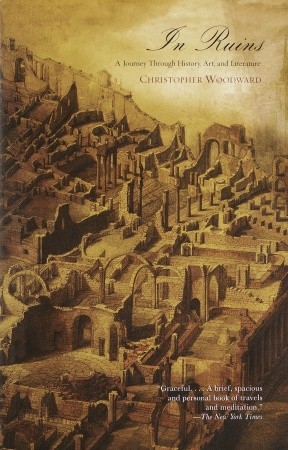In a lighthearted reference, Christopher Woodward begins his book with the image of Charlton Heston finding the ruins of the Statue of Liberty in Planet of the Apes—an image prefigured in 1826 by Mary Shelley in her post-apocalyptic novel, The Last Man, and by an 1873 painting by Gustave Doré depicting the destruction of London. Most of Woodward’s historical and literary anecdotes, in fact, center on a solitary figure picking his way through ancient and lonely ruins. From Lord Byron to Henry James, Chateaubriand to Adolf Hitler, Woodward focuses on the individual’s reaction to the ravages of time as he contemplates the ruins of past splendor. It is this personal fascination with ruins, and the ruminations on life and mortality they inspire, that Christopher Woodward charts in this masterful work.
Vividly populating his pages with a cavalcade of intriguing artists, writers, poets, priests, aristocrats, and even certified nutcases, Woodward examines the hypnotic hold ruins have exerted through the ages. In a series of loosely organized chapters, Woodward not only discusses what he calls the “Ozymandias complex”—ruins as an obvious symbol of the rise and fall of empires—but also examines the role of ruins in other areas of thought, ranging from Christian meditations on the vanitas of worldliness to aristocratic “sham castles” constructed to beautify a view. Part travel-writing, part cultural history, and part personal essay, In Ruins surpasses categorization; everywhere, however, Woodward’s love of the mystique of ruins and his knack for evoking bygone figures is entrancing.
Woodward’s fascination with ruins and his admiration for the artists and thinkers who have drawn inspiration from them contrast with his dislike of the scientist, archaeologist, and tourist, and the mentality they represent. Disappointed by the modern state of the Baths of Caracalla, an inspiration for the poet Percy Bysshe Shelley, Woodward tells us that:
A ruin has two values. It has an objective value as an assemblage of brick and stone, and it has a subjective value as an inspiration to artists. You can uproot that alder tree, superintendente, erect more fences, spray more weed-killer, excavate and polish. You will preserve every single brick for posterity, and analyse the very occasional discovery of a more ornamental fragment in a learned publication. You will have a great many bricks, but nothing more. If the archaeologists had arrived before Shelley there would be no Prometheus Unbound.
For a ruin to cast its spell, man’s interfering hand must be out of the picture. Not only do archaeologists, according to Woodward, treat the exquisite beauty of nature overlaying a ruin as mere “curlicues to amuse an artist’s pencil,” but the commercialization of a ruin, the creation of paths, ropes, and “keep off the grass signs,” destroy the essential focus on the individual.
While not everyone shares his desire to do away with historical preservation, Woodward nevertheless isolates the deep appeal of personal communion with nature and time. Occasionally, his personal explorations border on the deranged and illegal, as when he frightens a party of Italian tourists, or when he gets hauled off by Greek policemen. But without a doubt, in tourist spots jam-packed with camera-toting sightseers and importunate postcard vendors, we lose much of the magic captured in the works of great artists and writers whose inspirational ruins were untainted by modern civilization. In Ruins is a delightful and thought-provoking study of the eternal hold of desuetude and decay over the human imagination.

